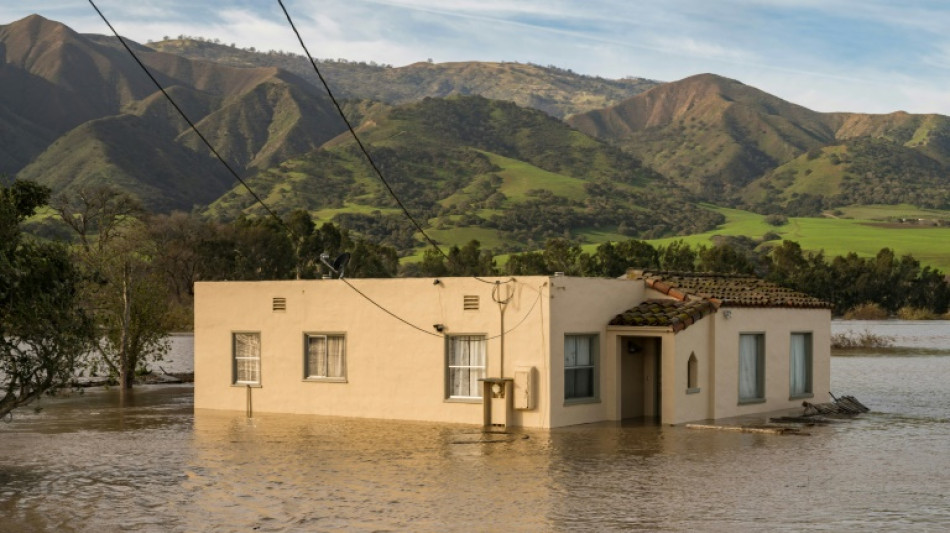
-
 Ukraine slams Scholz after first call with Putin in two years
Ukraine slams Scholz after first call with Putin in two years
-
Michael Johnson's Grand Slam Track series to have LA final

-
 Kagiyama, Yoshida put Japan on top at Finland Grand Prix
Kagiyama, Yoshida put Japan on top at Finland Grand Prix
-
Alcaraz eyeing triumphant Davis Cup farewell for Nadal after ATP Finals exit

-
 Xi, Biden at Asia-Pacific summit under Trump trade war cloud
Xi, Biden at Asia-Pacific summit under Trump trade war cloud
-
India go on record six-hitting spree against South Africa

-
 France skipper Dupont says All Blacks 'back to their best'
France skipper Dupont says All Blacks 'back to their best'
-
Trump pressures US Senate with divisive cabinet picks

-
 Bagnaia strikes late in Barcelona practice to edge title rival Martin
Bagnaia strikes late in Barcelona practice to edge title rival Martin
-
High-ball hero Steward ready to 'front up' against South Africa

-
 Leader of Spain flood region admits 'mistakes'
Leader of Spain flood region admits 'mistakes'
-
Swiatek, Linette take Poland past Spain into BJK Cup quarter-finals

-
 Leftist voices seek to be heard at Rio's G20 summit
Leftist voices seek to be heard at Rio's G20 summit
-
Wales coach Jenkins urges players to 'get back on the horse'

-
 Zverev reaches ATP Finals last four, Alcaraz out
Zverev reaches ATP Finals last four, Alcaraz out
-
Boeing strike will hurt Ethiopian Airlines growth: CEO

-
 Springboks skipper Kolisi wary of England's 'gifted' Smith
Springboks skipper Kolisi wary of England's 'gifted' Smith
-
End of a love affair: news media quit X over 'disinformation'

-
 US finalizes up to $6.6 bn funding for chip giant TSMC
US finalizes up to $6.6 bn funding for chip giant TSMC
-
Scholz urges Ukraine talks in first call with Putin since 2022

-
 Zverev reaches ATP Finals last four, Alcaraz on brink of exit
Zverev reaches ATP Finals last four, Alcaraz on brink of exit
-
Lebanon rescuer picks up 'pieces' of father after Israel strike

-
 US retail sales lose steam in October after hurricanes
US retail sales lose steam in October after hurricanes
-
Zverev reaches ATP Finals last four with set win against Alcaraz

-
 Kerevi back for Australia against Wales, Suaalii on bench
Kerevi back for Australia against Wales, Suaalii on bench
-
Spate of child poisoning deaths sparks S.Africa xenophobia

-
 Comedian Conan O'Brien to host Oscars
Comedian Conan O'Brien to host Oscars
-
Rozner overtakes McIlroy and Hatton for Dubai lead

-
 Mourners bid farewell to medic killed in east Ukraine
Mourners bid farewell to medic killed in east Ukraine
-
Gore says 'absurd' to hold UN climate talks in petrostates

-
 Hamas says 'ready for ceasefire' as Israel presses Gaza campaign
Hamas says 'ready for ceasefire' as Israel presses Gaza campaign
-
Amorim says Man Utd is 'where I'm supposed to be'

-
 Japan hammer Indonesia to edge closer to World Cup spot
Japan hammer Indonesia to edge closer to World Cup spot
-
Jeff Beck guitar collection to go under the hammer in January

-
 Veteran Ranieri has 'no time for mistakes' on Roma return
Veteran Ranieri has 'no time for mistakes' on Roma return
-
Van Nistelrooy says he will 'cherish' Man Utd memories in farewell message

-
 IAEA chief tours sensitive Iran nuclear plants
IAEA chief tours sensitive Iran nuclear plants
-
Pompeii rejects 'mass tourism' with daily visitor limit

-
 Jailed Russian poet could be 'killed' in prison, warns wife
Jailed Russian poet could be 'killed' in prison, warns wife
-
French court orders release of Lebanese militant held since 1984

-
 Global stocks struggle after Fed signals slower rate cuts
Global stocks struggle after Fed signals slower rate cuts
-
UK economy slows, hitting government growth plans

-
 Primary schools empty as smog persists in Indian capital
Primary schools empty as smog persists in Indian capital
-
Palestinians turn to local soda in boycott of Israel-linked goods

-
 Typhoon Man-yi bears down on Philippines still reeling from Usagi
Typhoon Man-yi bears down on Philippines still reeling from Usagi
-
UK growth slows in third quarter, dealing blow to Labour government

-
 Chris Wood hits quickfire double in NZ World Cup qualifying romp
Chris Wood hits quickfire double in NZ World Cup qualifying romp
-
Markets struggle at end of tough week

-
 China tests building Moon base with lunar soil bricks
China tests building Moon base with lunar soil bricks
-
Film's 'search for Palestine' takes centre stage at Cairo festival

| RBGPF | 2.67% | 61.84 | $ | |
| RYCEF | 0.15% | 6.8 | $ | |
| CMSC | -0.12% | 24.52 | $ | |
| SCS | -0.53% | 13.2 | $ | |
| NGG | 0.33% | 62.575 | $ | |
| BTI | 2.03% | 36.225 | $ | |
| CMSD | 0.22% | 24.4105 | $ | |
| AZN | -2.7% | 63.33 | $ | |
| GSK | -1.75% | 33.415 | $ | |
| RELX | -3.57% | 44.368 | $ | |
| RIO | 0.69% | 60.85 | $ | |
| VOD | 0.86% | 8.755 | $ | |
| JRI | -0.24% | 13.045 | $ | |
| BCC | -0.54% | 139.6 | $ | |
| BCE | -0.04% | 26.83 | $ | |
| BP | -0.48% | 28.91 | $ |

US west coast girds for more damaging storms
Western US states were readying Thursday for yet more torrid weather as so-called atmospheric rivers lined up to dump heavy rain across the already soaked region.
California has been battered by weeks of downpours that have killed 19 people, flooding communities, toppling powerlines and threatening deadly mudslides.
Forecasters now say a cyclone churning in the Pacific Ocean will spread the rain further north, forming a band from northern California to Washington state.
"The relentless parade of cyclones that have been targeting California in the past week is forecast to shift focus," the National Weather Service said Thursday.
A strengthening ridge of high pressure will "keep the heaviest precipitation locked in place across northern California to coastal Pacific Northwest," which includes Oregon and Washington state.
"By Friday night, this somewhat stagnant pattern will show signs of breaking down, allowing the next Pacific cyclone to direct yet another surge of atmospheric river toward California by Saturday morning."
Forecasters said they expect up to six inches (15 centimeters) of rain to fall over 48 hours near Seattle.
Avalanche warnings were in effect for a tranche of Washington state, with the storm bringing wetter, heavier snow into the mountains.
"Dangerous, large avalanches are expected to run naturally during this snowy, wet weather event that will be impacting us Thursday," the Northwest Avalanche Center (NWAC) said.
So-called "wet slab avalanches" were a particular concern as the wetter snow piles up on top of fluffier, lighter snow, making the snowpack unstable.
"Wet slab avalanches are not something to tiptoe around, and this is a day where it's a good idea to stay off steep slopes and runouts beneath avalanche paths," the NWAC said.
- Sewage -
In northern California, up to six feet (1.8 meters) of snow was forecast over the mountains between Friday and Tuesday, with winds gusting up to 50 miles (80 kilometers) an hour.
"Mountain travel is highly discouraged this weekend! If you must travel, plan to be at your destination before 4pm Friday," the NWS said.
At lower elevations, a flood watch was in place in a vast area from around San Francisco and into Oregon.
The warnings come as the region picked up the pieces after repeated downpours.
San Francisco saw more rain over a two-week period than at any other time in 150 years, straining the city's drains where raw sewage was mixed with storm run off.
"Don’t jump in puddles. Especially in San Francisco...there (could be) sewage in that," said Eileen White of the regional Water Quality Control Board, according to the San Francisco Chronicle.
The storms have left at least 19 people dead in California.
They include drivers who have been found in submerged cars, people struck by falling trees, a husband and wife killed in a rockfall, and people whose bodies were discovered in floodwaters.
In San Luis Obispo, members of the National Guard joined the search for 5-year-old Kyle Doan, who was swept away in floodwaters as his mother tried to pull him to safety from their car.
The sheriff of San Luis Obispo County said Wednesday that underwater teams were combing water courses.
"We will search until we find him," spokesman Tony Cipolla told The San Luis Obispo Tribune.
- Climate change -
California is no stranger to wild weather, with winter storms commonplace.
But scientists say climate change, supercharged by humanity's burning of fossil fuels, is making such storms more ferocious.
While it is causing short term misery, the rain is badly needed in the western United States, where more than two decades of drought have forced unprecedented restrictions on water usage.
However, climatologists warn that even the kind of monster downpours that have pummelled the region this month are not going to reverse 20-plus years of below-average rainfall.
Shasta Lake, the state's largest reservoir, was still only at two-thirds of its historical average for early January, water resources department data showed.
O.Brown--AT


